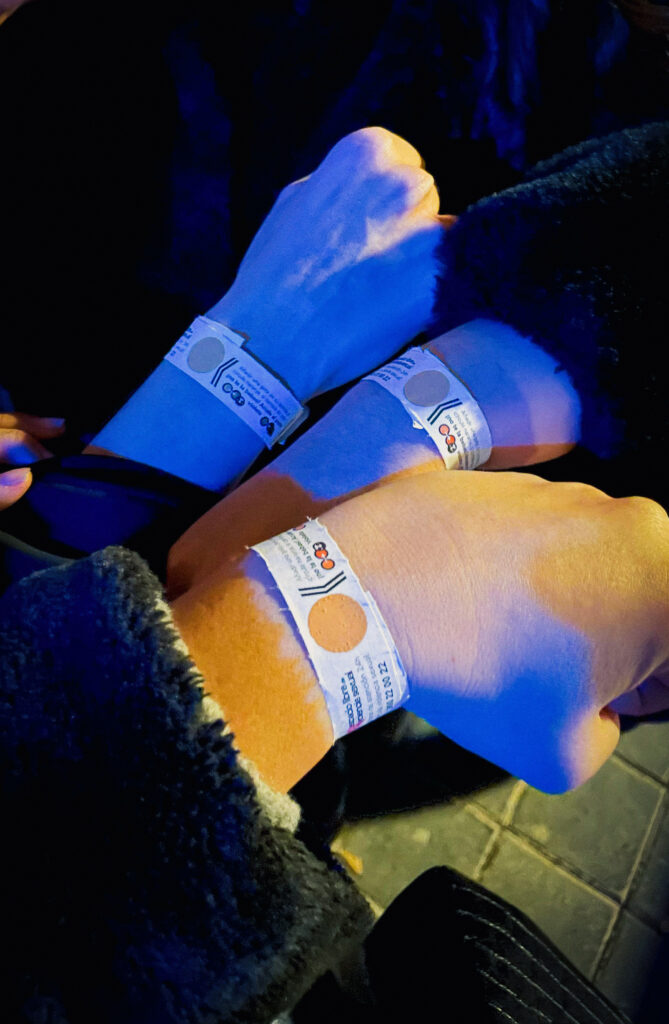Store
Celentis Drug-Spiking Detection Wristband
The solution that transform safety at events
Our innovative wristband allows for the immediate detection of drug-spiking substances, such as GHB (liquid ecstasy), in beverages. With a simple and discreet design that fits any environment, it provides an effective and low-cost solution, making it ideal for use in various social settings—from festivals and nightclubs to private gatherings—ensuring safer and more responsible spaces.
Complete kit with Verification Vials
Each order of detection wristbands can be complemented with a verification vial kit. These vials confirm any positive results, providing users with confidence and peace of mind. Additionally, our wristbands are perfect for distribution in accordance with Gender Violence Prevention protocols at “Purple Points”, customer service areas, or “Safe Spaces” in venues and events, enhancing accessibility and usability.
Technical Specifications
Usage Instructions
1. Place a drop of your drink on the reactive area of the wristband.
2. Observe the result:
Dark green color change: Indicates the presence of GHB in the drink.
Color change from light yellow to orange to indicate the presence of Burundanga, Ketamine, and Cathinones.
3. If a color change is detected, DO NOT consume the beverage and inform a trusted person or security staff.
Applications
1. Events & Festivals – Protection in large gatherings.
2. Nightclubs & Bars – A preventive tool for nightlife safety.
3. Purple Points & Emergency Services – Ideal for awareness and safety campaigns.
4. Personal Use – A discreet and practical device for any occasion.

Certification & Safety
The Celentis wristband complies with European product safety regulations (Directive 2001/95/EC), ensuring high quality and reliability. Additionally, it holds REACH certifications, confirming the use of health- and eco-friendly materials.

Pricing & Contact
Would you like more information about pricing and kit combinations?
Contact us to design the solution that best fits your needs. Our commercial department will assist you in calculating the ideal quantities and in combining wristbands with verification vials according to the size of your event, venue, or institutional campaign.
Write to us at celentis@celentis.bio, call us at [666232004], or send your inquiries through the contact form.
Celentis is revolutionizing on-site detection of drink-spiking drugs, offering an accessible, reliable, and effective solution.
The Celentis Bracelet meets the highest standards of safety and dermatological compatibility
At Opticalsens, user safety is an absolute priority. That is why the Celentis SC-Event Bracelet has undergone rigorous clinical and chemical testing carried out by accredited laboratories and nationally and internationally recognized organizations.
–Total compatibility with human skin
The bracelet has successfully passed patch testing in two independent studies conducted on volunteers with normal and sensitive skin.
The tests were performed in accordance with Good Clinical Practice (GCP), the principles of the Declaration of Helsinki, and current European regulations.
Result: 0% dermal reactions in all participants, confirming excellent skin tolerance.
–REACH compliance: safe materials for health and the environment
The Celentis Bracelet has been analyzed under Regulation (EC) No 1907/2006 (REACH), meeting all requirements related to Phthalates (Entries 51 and 52 of Annex XVII), Chromium (VI), Lead and Cadmium.
All results fall well below the permitted limits, ensuring the absence of hazardous or allergenic substances in the materials used.
-An innovative design, backed by science and responsibility
The Celentis Bracelet is not only a breakthrough in preventive detection, but also a product designed with full respect for the skin, the environment, and European safety standards.
With this level of commitment, we offer users maximum confidence and peace of mind in everyday use.
It’s Celentis, it’s safe.
